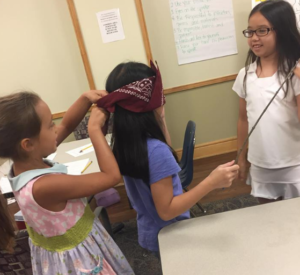Summer SAVY 2018: Session 2, Day 1 – Animal Communications (Rising 3rd and 4th)
Rising third and fourth graders dove into Animal Communication today like peregrine falcons on a stoop! Day 1 was full of learning and activities. After getting to know each other with some animal charades, the kids discovered their inner honeybees. We started with an exercise where teams lined up in the hall and sent workers to forage for their colored tickets (which were hidden around the classroom). If they found a patch, worker-bee-students had to report back to their teammates (at the hive) and describe the location. In round 2, they had to do the same task without speaking. To do so, they replicated the task faced by honeybees, and came up with their own waggle dance to convey the location of the ticket caches. Dr. Alissa and Dr. Matt were blown away by how well the students performed at this task. Each team came up with an entirely different solution for conveying these locations! One used stepwise referential instructions (like forward one step, turn left, forward two steps); one group developed a series of signs (a simple sign language) to indicate placement on or below tables or on chairs; one simply indicated a vector (i.e. direction of the cache); and one group divided the room into 9 regions (referring to an imaginary grid in the air). This was actually an uncanny performance, that outranked what many high schoolers (or adults for that matter) would have done!
And this was only the beginning! Students later learned about amblypygid communication, trying to compete against each other with antenniform leg oscillations. They learned about the diversity of animal sensory systems, and about how natural selection allows organisms to adapt to their environments (which we’ll build on to understand how communication systems evolve over time). Lastly, students performed a somewhat complicated selection experiment (Dot Harvest) to help understand how birds selecting for color morphs of moths can lead to the creation of more camouflaged (cryptic) moths.
Tomorrow, students can look forward to getting outside and observing organisms around campus–and beginning to build up their visual and acoustic search images for urban animals. And much more! See you all bright & early!
-Dr. Matt and Dr. Alissa
Pretending to be Amblypgids

